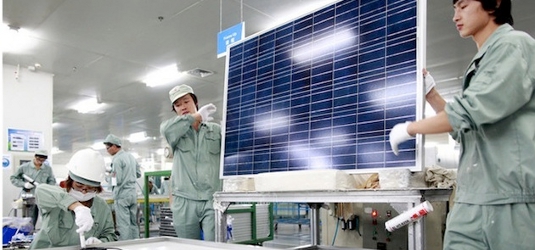Trina Solar, the Chinese Tier-1 solar company, has announced this week that it has achieved a new record efficiency for PERC solar cells.
The company says that it has reached 21.1% average efficiency for its P-type monocrystalline cells with passivated emitter and rear cell (PERC) technology, produced in standard industrial conditions on a cell measuring 156 x 156 mm2 and reaching an output power of 300 watts (W).
However, at this stage the efficiency has only been tested by Trina itself, and thus far have not been independently verified by a third-party testing lab.
According to Trina, the P-type mono PERC cell was produced on a large-size industrial boron-doped Cz-Si substrate at the company’s golden pilot production line in China using “standard industrial production materials and processes”. It is this transition from laboratory to mass production technology that has been the Holy Grail for cell developers.
“We are proud of our latest achievement in attaining an average conversion efficiency rate of 21.1% for our monocrystalline PERC cells that were industrially produced by applying our laboratory world record PERC cell technology,” said Trina Solar’s VP and chief scientist, Pierre Verlinden.
Trina Solar’s director of the State Key Laboratory of PV Science and Technology, Zhiqiang Feng, added that the company’s goal has long been to focus on technological innovation and to be able to transfer its best laboratory practices and techniques to commercial production.
“As demand for high-efficiency cells increases,” Feng said, “our R&D team’s achievement in raising the average efficiency of our industrially produced mono PERC cells will help accelerate the applications of high-efficiency solar products and build a solid foundation for further reductions in the LCOE.”
The competition to drive mono PERC efficiencies to new heights has become fierce in 2016, with Taiwan’s Gintech achieving a 21.44% efficiency in January under laboratory conditions, with mass-production expected to follow later this year. SolarWorld, too, upping its efficiency to 22% for mono PERC cells in January. The company said at the time that it would take “one to two years” to transfer this efficiency into mass production.
This content is protected by copyright and may not be reused. If you want to cooperate with us and would like to reuse some of our content, please contact: editors@pv-magazine.com.








By submitting this form you agree to pv magazine using your data for the purposes of publishing your comment.
Your personal data will only be disclosed or otherwise transmitted to third parties for the purposes of spam filtering or if this is necessary for technical maintenance of the website. Any other transfer to third parties will not take place unless this is justified on the basis of applicable data protection regulations or if pv magazine is legally obliged to do so.
You may revoke this consent at any time with effect for the future, in which case your personal data will be deleted immediately. Otherwise, your data will be deleted if pv magazine has processed your request or the purpose of data storage is fulfilled.
Further information on data privacy can be found in our Data Protection Policy.